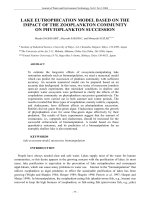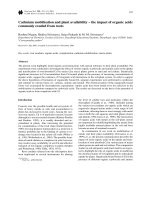Cadmium mobilisation and plant availability the impact of organic acids
Bạn đang xem bản rút gọn của tài liệu. Xem và tải ngay bản đầy đủ của tài liệu tại đây (94.68 KB, 7 trang )
Plant and Soil 230: 107–113, 2001.
© 2001 Kluwer Academic Publishers. Printed in the Netherlands.
107
Cadmium mobilisation and plant availability – the impact of organic acids
commonly exuded from roots
Rashmi Nigam, Shalini Srivastava, Satya Prakash & M. M. Srivastava
1
Department of Chemistry, Faculty of Science, Dayalbagh Educational Institute, Dayalbagh, Agra-282005, India.
1
Corresponding author
∗
Received 11 July 2000. Accepted in revised form 14 November 2000
Key words: root exudates, organic acids, complexation, cadmium solubilisation, maize plants
Abstract
The present work highlights metal-organic acid interactions with special reference to their plant availability. Pot
experiments were conducted to investigate the effect of various organic (carboxylic and amino) acids on the uptake
and translocation of root-absorbed Cd by maize (Zea mays) plants grown in sand and soil culture. Statistically
significant increases in Cd accumulation from Cd-treated plants in the presence of increasing concentrations of
organic acids, suggest the existence of Cd-organic acid interactions in the soil-plant system. In order to support
the above hypothesis of formation of organically bound Cd, separate experiments were performed to synthesize
and estimate its various forms viz. cationic, anionic and neutral. The chemical nature of the organically bound
forms was ascertained by electrophoretic experiments. Amino acids have been found to be less effective in the
mobilisation of cadmium compared to carboxylic acids. The results are discussed on the basis of the potential of
organic acids to form complexes with Cd.
Introduction
Concern over the possible health and ecosystem ef-
fects of heavy metals in soils and accumulation in
plants has increased in recent years. Among the vari-
ous toxic metals, Cd is of particular concern, because
althoughit is not an essential element (Kabata-Pendias
and Pendias, 1992), it is readily absorbed and ac-
cumulated in plants, thus increasing the potential
for contamination of the food chain (Galal-Gorchev,
1993). Its long-distance translocation as a metal ion is
limited, probably due to the binding of cations to ex-
change sites located in the xylem cell walls (White et
al., 1981; Wolterbeek et al., 1984). The possible form-
ation of metal chelates or complexes in soils, however,
may result in easy availability of soil Cd and effective
transport of Cd-organic complexes in plants (Senden
and Wolterbeek, 1990; Tiffin, 1970, 1972).
Root exudates released into the rhizosphere have
been implicated in several mechanisms for altering
∗
FAX No.: +0562 281226
the level of soluble ions and molecules within the
rhizosphere (Cataldo et al., 1988). Included among
the various root exudates are organic acids which are
negatively charged anions under a wide range of soil
conditions, allowing them to react strongly with metal
ions in both the soil aqueous and solid phases (Jones
and Darrah, 1994; Jones et al., 1996). The interactions
of organic acids with metals in the soil-plant system
are important for solubilising/binding the metals from
highly insoluble mineral phases in the soil and have
become an area of sustained research.
In continuation of our work on mobilisation of
metals and their plant availability (Srivastava et al.,
1999 a, b, c), the present communication describes the
impact of some organic acids on the uptake and trans-
location of root-absorbed Cd in various parts of maize
plants grown in sand and soil culture. The comparative
studies in soil and quartz sand (inert matrix) are expec-
ted to highlight the role of organic acids in modifying
the chemical nature of Cd supplied and its subsequent
uptakeby plants. Organicallyboundformsof Cd in the
presence of different organic (carboxylic and amino)
108
acids, have been estimated in separate experiments
using ion exchange chromatography. Electrophoretic
experiments have also been conducted to determine
the chemical nature of organically bound Cd.
Materials and methods
Pot experiments under laboratory conditions were per-
formed using maize (Zea mays) plants grown for 60
d in sand and soil (2.5 kg) using plastic containers.
Quartz sand was used after prescribed washings (He-
witt, 1966). Plants grown in sand were irrigated with
a complete nutrient solution (Hoagland and Arnon,
1950). Various parameters of soil samples were char-
acterised by the Nuclear Research Laboratory (NRL),
Indian Agricultural Research Institute (IARI), New
Delhi. The soil used in the experiment has the fol-
lowing characteristics: sandy loam inceptisol, pH 7.4,
EC 0.23 ds/m, organic carbon 0.8 g/kg, total Cd
0.012 µmol/L, bulk density 1.25 g/cm
3
, CEC (cation
exchange capacity ) 25.7 cmol (+)/kg, soluble ions
Ca 108, Mg 432, Na 1403, K 35, Cl 2023, SO
4
624 mg/kg. Abasal dose of N:P:K (60:20:18 mg /kg of
soil ) was initially supplied. The plants were irrigated
with distilled water as and when required.
A carrier solution of cadmium nitrate was tagged
with Cd-115 m radiotracer.Treatments started by ap-
plying to the surface of growing media of 60-day-
old plants a single pulse addition of a solution (200
mL) containing radiolabelled Cd (44 µm) with vary-
ing amount of different organic acids: citric acid
(23,237,474,1189,2379 µm), malic acid (37, 373,
746, 1865, 3731µM), aspartic acid (37, 375, 750,
1878, 3756 µm) and glycine (66, 666, 1333, 3333,
6666 µm) in order to obtain Cd: organic acid ra-
tios (1:1,1:10,1:20,1:50 and1: 100 w/w) These are the
predominant acids released by maize plants in root
exudates (Mench and Martin, 1991). The pH of the
solution was finally adjusted to 5.5 with 0.1 N HCl.
Cd-115m was obtained from Board of Radiation and
Isotope Technology (BRIT), BARC, Mumbai. Plants
were grown with these treatments for 10 d. Natural
light (diurnal cycle of 14 h) was supplemented with
Phillips Fluorescent tubes (40 W) and Toshiba lamps
(15 W) providing an irradiation of approximately 600
W/m
2
at the plant tops. Plants were harvested and
washed thoroughly with tap water, followed by pH 4
water and distilled water. They were then cut into root,
shoot and edible parts and packed into plastic vials for
oven drying (50
◦
C) to obtain dry matter yields. The
pH of the final washings were tested to ensure that no
detectable acidity was left.
Accurately weighed amounts of plant material
were counted over a planar NaI (TI) detector coupled
to a 4 K MCA ( Canberra Accuspec Card with PC-AT
386). The counting geometry was pre calibrated for ef-
ficiency with known amount of Cd-115m activity from
the 0.934 MeV photopeak area. The activity of Cd-
115m was calculated and reported as Cd in different
parts of plant per gram of dry weight.
Source-to-plant transfer coefficients (SPT) for Cd
with increasing organic acid supplementation in both
sand and soil medium were calculated by dividing the
Cd concentration in the plants (DW) by Cd concentra-
tion in feeding solution.
A quantity of Cd (100 µm) was taken in Er-
lenmeyer flasks and radiolabelled with Cd-115m
tracer. Organic acids; Carboxylic acids: Citric acid
and Oxalic acid: Amino acids: Aspartic acid and
Glutamic acid were added separately in the ratio (1:20
w/w).Ionic strength was maintained by adding KNO
3
solution (20 mM). After adjusting to pH 6, the solution
was shaken for 16 h and the supernatant was removed
after centrifuging for 45 min. The supernatant solu-
tion, representing the organically bound form, was
subjected to chemical speciation. Based on the inher-
ent capability of the combination of radiotracer and
ion-exchange resins, i.e. Amberlite XAD (neutral),
Dowex-50 (cationic) and Dowex-1 (anionic) (Batley,
1991), the percentage of neutral, cationic and anionic
forms of the organically bound Cd was estimated. The
quantification (%) of different forms of organically
bound Cd was calculated by difference, using the pro-
cedure of Deb et al.(1976). Electrophoretic radioassay
was also carried out to ascertain the existence of or-
ganically bound Cd in neutral, anionic and cationic
forms.
The data represent the mean of three replicates
of four plants per pot. Statistical analyses were per-
formed using SPSS/PC
+
M software package. Testing
for non-normal data distributions was computed by
Mann Whitney (independent) U test comparing indi-
vidual means. Correlation coefficients were used to
relate concentration in root and aerial parts to various
organic acid treatments.
Results
Table 1 shows the accumulation of Cd in various plant
parts supplied with 44 µm of Cd in the presence
109
Table 1. Plant tissue concentrations of cadmium (µg/g dry weight) in maize plants
supplied with cadmium (44 µm) in the presence of varying concentrations of organic
acids
Conc. ratio Sand Culture Soil Culture
Cd:Org. Root Shoot Fruit Root Shoot Fruit
acids
Citric acid
1:1 93±933±68.3±1.0 78±719±37.5±0.7
1:10 138±544±5 10.4±0.9 88±623±49.8±0.9
1:20 144±454±4 11.6±0.8 95±531±6 10.8±0.3
1:50 152±759±4 13.5±1.1 112±840±5 11.5±0.1
1:100 172±866±5 15.4±1.2 128±747±5 13.4±0.2
p 0.020 0.001 0.000 0.020 0.001 0.004
Malic acid
1:1 90±830±48.0±0.8 70±815±37.2±0.6
1:10 132±636±49.3±0.7 80±722±49.2±1.0
1:20 141±642±5 10.1±0.5 89±830±6 10.1±0.6
1:50 149±449±6 12.2±0.6 108±937±3 11.1±0.5
1:100 155±458±7 14.2±1.5 119±841±4 12.8±0.7
p 0.036 0.000 0.002 0.004 0.001 0.001
Aspartic acid
1:1 53±723±37.8±0.3 38±611±37.0±0.8
1:10 63±832±38.3±0.3 45±518±58.0±0.4
1:20 75±637±49.9±0.2 57±627±49.5±0.5
1:50 94±742±4 11.1±0.1 65±732±3 10.2±0.6
1:100 106±846±3 12.8±0.3 84±636±3 11.9±0.5
p 0.001 0.001 0.002 0.002 0.001 0.001
Glycine
1:1 49±821±27.7±0.3 35±410±26.8±0.8
1:10 60±628±48.2±0.1 41±415±48.0±0.3
1:20 69±734±49.5±0.5 53±622±59.1±0.6
1:50 91±841±3 10.6±0.4 63±728±49.9±0.3
1:100 101±646±4 11.5±1.1 80±10 35±4 10.5±0.2
p 0.002 0.001 0.001 0.020 0.000 0.001
Cd Conc. 41±618±26.1±0.9 31±39±0.5 6.2±0.3
without
Org. acid
(control exp.)
Values±SD
of increasing concentrations of various organic acids.
The distribution of Cd in various parts of maize plant
shows the following order: root > shoot > fruit.
Cd added with organic acids (1:1, 1:10, 1:20, 1:50
and 1:100 w/w) resulted in statistically significant in-
creases in Cd accumulation in root and aerial parts of
the plant in both the sand and soil cultures (p≤ 0.03).
Relatively higher increases in Cd accumulation were
observed in plants grown in sand. (Mann Whitney
U-test p≤ 0.03).
The effect of organic acid amendments on the Cd
enrichment from the Cd treatment has been calculated
in terms of the source-to-plant transfer (SPT) coeffi-
cient (Table 2). Experiments showed that the affinity
110
Table 2. Source-to-plant transfer coefficients for cadmium in maize plants treated with cadmium in
the presence of organic acid supplementation
Conc. ratio Cd in Sand Cd in Soil
Cd:Org. Citric Malic Aspartic Glycine Citric Malic Aspartic Glycine
acid acid acid acid acid acid acid
0 13.0 13.0 13.0 13.0 9.2 9.2 9.2 9.2
1:1 26.9 25.6 16.8 15.5 20.7 18.4 11.2 10.4
1:10 38.5 35.7 20.7 19.2 24.2 22.2 14.2 12.8
1:20 41.9 38.6 24.4 22.5 27.4 25.8 18.7 16.8
1:50 44.9 42.0 29.4 28.5 32.7 31.2 21.4 20.2
1:100 50.7 45.4 31.8 31.7 37.7 34.6 26.4 25.3
of organic acids for complexation with Cd was (Mann
Whitney U-test): citric > malic > aspartic ≈ glycine.
To support the hypothesis of the formation of
organically-boundCd, separate experiments were per-
formed to synthesize organically-bound Cd [Cd- citric
acid, Cd-malic acid and Cd-aspartic acid] and are
depicted in Figure 1.
Discussion
The distribution of Cd in the plant tissues (root, shoot
and fruit) indicated that 70–80% of the Cd was re-
tained in roots and only a small proportion, was trans-
located to aerial parts. Jarvis et al. (1976)also reported
that more than 70% of supplied Cd was incorporated
in roots of Zea mays and other plants. Increasing con-
centrations of organic acids increased plant uptake of
Cd, with a similar trend of distribution ratio as ob-
tained in control experiments where no organic acid
was provided.
An increase in Cd uptake from the Cd treatments
with increasing supplementation of organic acids may
be ascribed to the interaction of Cd with organic
ligands leading to the formation of mobile organically-
bound Cd. Peterson and Alloway (1979) have also
recorded that organically complexed Cd was more
readily translocated than similar amounts of the ionic
form.Organic acids such as citric,malic,oxalic,aspartic
and glutamic acids, have been reported as being po-
tential metal chelators (Nakayama, 1981; Naidu and
Harter, 1998).
Higher uptake of Cd from the treatment of Cd
with organic acids occurred in plants grown in sand
as compared to soil (Table 1). Quartz sand being in-
ert in nature, does not have a sorption tendency for
Cd, therefore, provides a better site for Cd- organic
acid complexation. Moreover, the slower degradation
of the organic complex of the cadmium is accepted
in the sand medium. On the contrary, soil has greater
capacity to adsorb Cd
2+
ions (Haghiri, 1974; Miller
et al., 1976) and thus reduces the extent of Cd or-
ganic acid complexation, resulting in a lower plant
availability. There was an increasing trend in SPT val-
ues of Cd with increasing concentration of organic
acids provides further support to the demonstration of
the existence of Cd-organic acid interaction (Table 2).
SPT coefficients for Cd uptake when no organic acid
was provided, are considered as a reference standard.
Poor correlation (non-significant at p< 0.03)
between the dry matter yield and organic acids ad-
dition indicates that the treatments imposed have no
toxic effects. The non-toxic behaviour in spite of Cd
accumulation in the plants, may be ascribed to the
fact that organic ligands not only enhance the solu-
bility of the trace metals, but also reduce their toxicity
to plants (Sposito, 1985). The free trace metal ions
are reported to be more toxic compared with organic-
ally complexed molecules (Xue Dongsen et al., 1995).
However, a slight decrease was observed in dry matter
yield of plants grown in sand culture amended with the
highest concentration of citric acid ( Cd: Citric acid;
1:100).
The metal-solubilising ability of the organic acids
is parallel to their metal binding ability (Mench
and Martin, 1991) which in turn is correlated with
their dissociation constants. The dissociation con-
stants (Ka
1
,Ka
2
) for citric acid (7.10 × 10
−4
,1.68 ×
10
−4
), malic acid (3.9 × 10
−4
,7.8× 10
−6
), aspartic
acid (1.38 × 10
−4
) and glycine (1.67 × 10
−10
)arein
conformitywith the order obtainedin our experiments.
From Table 1, Cd complexation and resulting up-
take are low for amino acids as comparedto carboxylic
111
Figure 1. % of formation of organically bound form of Cd with citric, malic and aspartic acids.
acids. Carboxylic acids, particularly citric and malic
acids, can bind divalent cations strongly and form
stable complexes (Cieslinski et al., 1998; Senden and
Wolterbeek, 1990). Furthermore, the efficiency of cit-
ric acid towards metal complexation over malic acid
has been previously reported (White et al., 1981). It is
also suggested that proteinaceous amino acids released
into the rhizosphere do not play a major role in mobil-
ising metals from the soil (Jones et al., 1994). Costa
(1997) has indicated that amino acids effect complex-
ation to lesser extent than carboxylic acids because of
their limited nutrient mobilisation capacity.
In recentyears, it has been emphasised that consid-
eration of total metal concentration does not provide
the real picture of bioaccumulation. It needs inform-
ation regarding various physicochemical forms of the
metals. Research attention has been focussed on the
formation of organically bound forms of the metals
virtually responsible for their uptake by plants by in
vivo and in vitro experiments. Any resulting complex
of a metal and a ligand (organic acid) might have a
net charge that can be negative, positive or neutral.
Cataldo et al. (1988) complexed the whole exudates
of soyabean plants with the Cd
2+
in vitro and reported
the existence of anionic and cationic forms of organic-
ally bound Cd. However, the electrophoretic shape of
the anionic component suggests that it is near neutral
in charge.
We have conducted separate experiments on syn-
thesis, electrophoreticnature (Figure 2) and estimation
of various forms of organically bound Cd (Figure 1).
Results clearly show the existence of all the three
forms – neutral, anionic and cationic species of or-
ganically bound Cd. However, the cationic form has
been found to be predominant in each case. Our ob-
servations are supported by the Donnan dialysis quan-
tification (Cox et al., 1984) showing that about 84% of
the Cd present in the plant extract was in the cationic
form which is more labile. The affinity of organicacids
under study to form cationic complex is found to be as
follows:
citric > malic > aspartic
Conclusions
Plant uptake of Cd from the Cd treatments with in-
creasing concentration of organic acids seems to be
the resultant of the interactions of Cd with organic lig-
ands resulting in the formation of mobile organically
bound Cd. The experiments highlight Cd: organicacid
interactionsas a major contributorforcadmiumuptake
by plants than similar amounts of the ionic form. The
extent of Cd complexation and its resultant uptake is
less for amino acids as compared to carboxylic acids.
Attempts on chemical speciation of organically bound
forms existing in neutral, anionic and cationic nature
provide support to the above facts.
112
Figure 2. Plot of counts vs. migration (cm) on the electrophoretic
strip for Cd (a) citric acid (b) malic acid.
Acknowledgements
The authors are grateful to Prof. P.S. Satsangi, Dir-
ector, Dayalbagh Educational Institute, Agra for
providing necessary facilities. Financial support given
by Board of Studies in Nuclear Science (BRNS),
Department of Atomic Energy (DAE) is gratefully
acknowledged. Thanks are due to Project Director,
Nuclear Research Laboratory, Indian Agricultural Re-
search Institute, New Delhi for help in getting soil
sample analysed.
References
Batley G E 1991 Trace elements speciation. Analytical methods and
problems, CRC Press Inc. Boca Raton. FL, USA. 365 p.
Cataldo D A, McFadden K M, Garland T R and Widung R E 1988
Organic constituents and complexation of nickel (II), iron (III) ,
cadmium (II) and plutonium (IV) in Soyabean xylem exudates.
Plant Physiol. 86, 734–739.
Cieslinski G, Van Rees K C J, Szmigielska A M, Krishnamurti G
S R and Huang P M 1998 Low-molecular-weight organic acids
in rhizosphere soils of durum wheat and their effect on cadmium
bioaccumulation. Plant Soil 203, 109–117.
Costa G, Michaut J C and Guckert A 1997 Amino acids exuded
from axenic roots of lettuce and white Lupin seedlings exposed
to different cadmium concentrations. J Plant Nutr. 20, 883–900.
Cox J A, Slonawska K, Gatchel D K and Hiebert A B 1984 Metal
speciation by Donnan dialysis. Anal. Chem. 56, 650–653.
Deb D L, Kohli C B S and Joshi O P 1976 Stability constants of Zn
II -humic acid complexes. Fert. Technol. 13, 25–29.
Galal-Gorchev H 1993 Dietary intake, levels in food and estimated
intake of lead, cadmium and mercury. Food Addit. Contam. 10,
115–128.
Haghiri F 1974 Plant uptake of cadmium as influenced by Cation
Exchange Capacity, organic matter, Zinc and soil temperature .
J. Environ. Qual. 3, 180–183.
Hewitt 1966 Sand and water culture methods used in the study of
plant nutrition.Technical communication 22, Common wealth
Agriculture Bureaux. England: 399–463.
Hoagland D and Arnon D I 1950 The water culture method for
growing plants without soils. Bull. Calilfornia Agric. Station.
346 p.
Jarvis S C, Jones H P and Hopper M J 1976 Cadmium uptake from
solution by plants and its transport from roots to shoots. Plant
Soil 44, 179–191.
Jones D L, Edwards A C, Donachie K and Darrah P R 1994 Role of
Proteinaceous amino acids released in root exudates in nutrient
acquistion from the rhizosphere. Plant Soil 158, 183–192.
Jones D L and Darrah P R 1994 Role of root derived organic acids
in the mobilization of nutrients from the rhizosphere . Plant Soil
166, 247–257.
Jones D L, Darrah P R and Kochian V L 1996 Critical evaluation of
organic acid mediated iron dissolution in the rhizosphere and its
potential role in root iron uptake. Plant Soil 180, 57–66.
Kabata- Pendias A and Pendias H 1992 Trace Elements in Soils and
Plants. 2nd edn. CRC Press Inc. Boca Raton. FL, USA. 365 p.
Mench M and Martin E 1991 Mobilization of cadmium and other
metals from two soils by root exudates of Zea mays L., Nicotiana
tabacum L. and Nicotiana rustica L Plant Soil 132, 187–196.
Miller J E, Hassett JJ and Koeppe D E1976 Uptake of cadmium by
Soyabeans as Influenced by soil cation exchange capacity, pH
and Available Phosphorus. J. Environ. Qual. 5, 157–160.
Nakayama E 1981 Chemical speciation of chromium sea water:
Effect of naturally occuring organic materials on the complex
formation of chromium III. Anal. Chim. Acta. 130, 289–294.
Naidu R and Harter R D 1998 Effect of different organic ligands on
Cadmium sorption and extractability from soils. Soil Sci. Soc.
Am. J. 62, 644–650.
Peterson P J and Alloway B J1979 Cadmium in soils and vegetation.
In The Chemistry, Biochemistry and Biology of Cadmium Ed.
M Webb, pp 45–93. Elsevier, North Holland Biomedical Press,
Amsterdam.
Senden M H M N and Wolterbeek H Th 1990 Effect of citric acid
on the transport of cadmium through Xylem vessels of excised
tomato stem-leaf systems. Acta Bio. Neet. 39, 297–303.
Sposito G 1985 The distribution of potentially hazardous trace
metals. In Concepts in Metal Toxicology: Metal Ions in Biolo-
gical systems. Ed. H Siegal, Dekker, New York.
Srivastava S, Prakash S and Srivastava M M 1999a Studies on
mobilization of chromium with acids. Bio Metals 12, 201–207.
113
Srivastava S, Shanker K, Prakash S and Srivastava M M 1999b
Bioavailability of chromium; An interactive aspect. J. Environ.
Biol. 20, 49–54.
Srivastava S, Prakash S and Srivastava M M 1999c Chromium
mobilization and plant availability – the impact of organic
complexation ligands. Plant Soil 212, 203–208.
Tiffin L O 1970 Translocation of iron citrate and phosphorus in
xylem exudate of Soybean. Plant Physiol. 45, 280–283.
Tiffin L O 1972 Translocation of micronutrients in plants. In
Mortvedt J J et al. (ed): Micronutrients in Agriculture. Eds. JJ
Mortvedt et al. pp 199–229. Soil Science Society of America.
Madison.
White M C, Chaney R L and Decker A M 1981 Metal complexation
in xylem fluid. III Electrophoretic evidence. Plant Physiol. 67,
311–315.
Wolterbeek H Th, Van Luipen J and De Bruin M 1984 Non-Steady
State xylem transport of fifteen elements into the tomato leaf as
measured by gamma-ray spectroscopy: a model. Plant Physiol.
61, 599–606.
Xue Dongser, Robert R H and Charles L H 1995 Effect of organic
acid on cadmium toxicity in tomato and bean growth. J Environ.
Sci. 7, 399–406.









